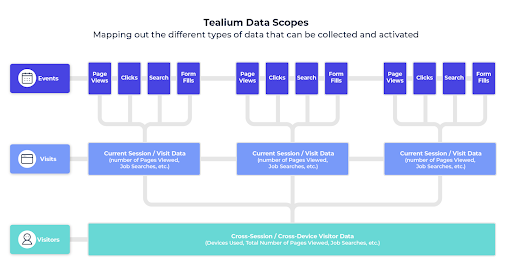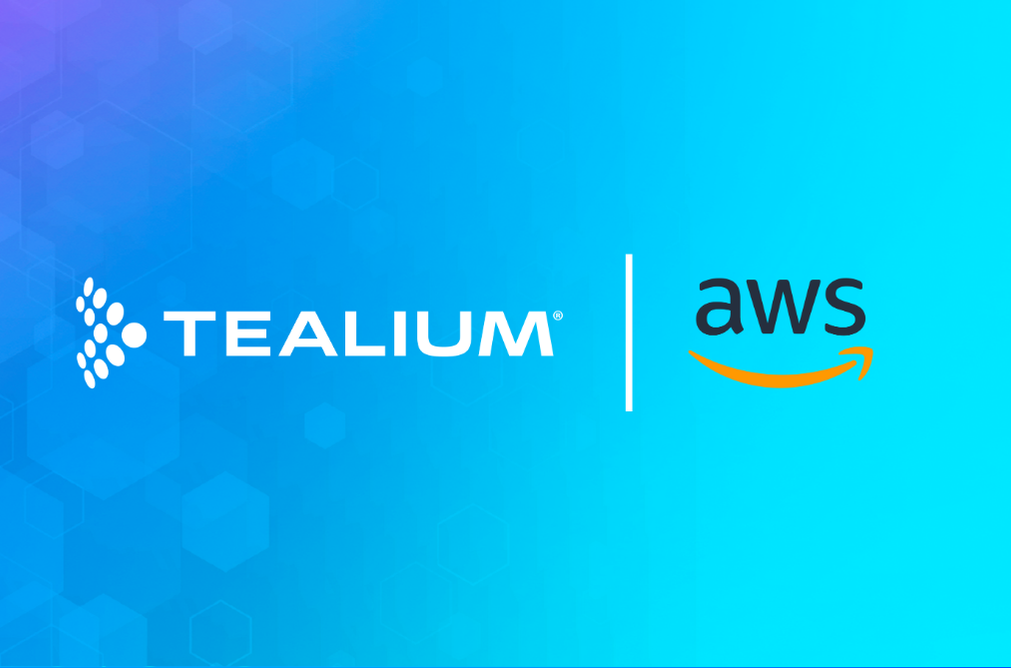Data Scopes as a Superpower
One of the most powerful aspects of Tealium’s Customer Data Platform is how it organizes customer data across three scopes: Event, Visit, and Visitor. Think of them as containers for time:
- Event = what’s happening right now
- Visit = what’s happening this session
- Visitor = who the customer is over time
Understanding these scopes helps you build smarter customer experiences that respond to engagement behavior in real-time while maintaining long-term context and automated labeling.
In this guide, we’ll dig into how these scopes work together and walk through two practical examples ready for prime time:
- Smart Cart Abandonment Recovery
- Real-Time Engagement Scoring
Understanding the Three Data Scopes
| Scope | Think of it as… | Best for… | Example attributes | Important note |
|---|---|---|---|---|
| Event (what’s happening right now) | A snapshot of the current action. Captures individual interactions as they happen—a page view, a button click, an item added to cart or a mouseover. This data exists only during that moment, processed in under 200ms. | Real-time personalization; Immediate recommendations; Event-triggered actions; Dynamic content updates; Foundational data building blocks; Raw behavioral interactions; Flat transactional data from batch sources | page_name, product_id, order_total, video_viewed | |
| Visit (the current session story) | A summary of a journey within a single session. Aggregates everything happening in-session. Gives you context about what the customer is doing during this particular visit, resetting with each new session. | Session-based engagement scoring; Exit intent offers; Cart, form, or conversion abandonment tracking; Progressive profiling; Single-session funnel engagement; Referral tracking on entry, attributed to later in session conversion | session_engagement_score, cart_total, pages_viewed | Web sessions timeout after 30 minutes of inactivity, mobile after 2 minutes, with a maximum duration of 24 hours. |
| Visitor (the complete customer story) | The customer’s complete history with your brand. Tracks behavior across all sessions, building a persistent profile over time. This is where you capture lifetime value, preferences, and long-term patterns. | Predictive analytics; Customer lifetime value; Churn prediction; Cross-session personalization; Consent preference and channel permissions; Channel preference; Lifecycle stage tracking; Demographic badging; NBA Segmentation; Test/Control assignment; First/Last Event Timestamp; Last purchase timestamp/amount/products | lifetime_order_value, customer_segment, days_since_last_purchase |

Practical Use Case: Smart Cart Abandonment Recovery
Let’s build something useful by combining all three scopes to identify and recover high-value abandoned carts.
Why this matters: With cart abandonment rates hovering around 70% globally, there’s significant revenue at stake. The good news? Targeted cart recovery emails can convert at rates of 10% or higher—and sending a 3-email sequence can generate up to 6.5x more revenue than a single email. By using Tealium’s multi-scope approach, you can identify which abandoned carts are worth pursuing and personalize your recovery efforts.
Step 1: Track Cart Activity (Event Scope)
First, ensure you’re capturing cart events as they happen. Your data layer should already include:
- tealium_event: “add_to_cart”
- product_id
- product_price
Step 2: Build Session Context (Visit Scope)
Create a visit attribute to track the current cart total:
| Attribute Name: current_cart_total |
| Scope: Visit |
| Data Type: Number |
| Enrichment: Increment or Decrement Number – Add value from: product_price – WHEN: Any Event – Rule: tealium_event EQUALS “add_to_cart” |
Track what’s in the cart:
| Attribute Name: products_in_cart |
| Scope: Visit |
| Data Type: Set of Strings |
| Enrichment: Update Set of Strings – Add value from: product_id – WHEN: Any Event – Rule: tealium_event EQUALS “add_to_cart” |
Step 3: Add Customer Intelligence (Visitor Scope)
Track lifetime purchase behavior:
| Attribute Name: lifetime_order_value |
| Scope: Visitor |
| Data Type: Number |
| Enrichment: Increment or Decrement Number – Add value from: order_total – WHEN: Any Event – Rule: tealium_event EQUALS “purchase” |
Calculate recency:
| Attribute Name: days_since_last_purchase |
| Scope: Visitor |
| Data Type: Number |
| Enrichment: Set Difference Between Two Dates – Date 1: Current Date – Date 2: last_purchase_date (another visitor attribute) – Units: Days – WHEN: New Visit |
Step 4: Identify High-Value Abandoners
Create an audience that combines insights from all three scopes:
| Audience: High-Value Cart Abandoners |
| Rule Logic: cart_total > $100 (visit scope) AND lifetime_order_value > $500 (visitor scope) AND days_since_last_purchase < 90 (visitor scope) |
| Trigger: Visit Ended (without purchase) |
Step 5: Activate
Connect this audience to your email platform, passing:
- cart_total (personalize messaging)
- cart_products (show abandoned items)
- lifetime_order_value (determine discount tier)
Expected results: Businesses using automated workflows for cart abandonment typically see a 50% increase in conversion rates. By targeting high-value customers with personalized recovery campaigns, you’re focusing your efforts where they’ll have the greatest impact.
Another Quick Win: Real-Time Engagement Scoring
Here’s a simpler example that creates immediate value. Research shows that 71% of consumers now expect personalized experiences, and personalization can boost conversion rates by over 20%. Engagement scoring helps you deliver the right experience to the right visitor in the moments that matter in real-time.
Create a Session Engagement Score (Visit Scope)
| Attribute Name: session_engagement_score |
| Scope: Visit |
| Data Type: Number |
| Add multiple enrichments: – +1 for page views – +5 for video plays – +10 for form submissions – +3 for product viewsEach enrichment triggers on “Any Event” with its specific rule. |
Categorize Engagement (Visit Scope)
| Attribute Name: engagement_level |
| Scope: Visit |
| Data Type: String (Badge) |
| Badge Rules: – “High” if score > 30 – “Medium” if score 10–30 – “Low” if score < 10 |
Make It Available for Personalization (One Method of Many)
Enable Data Layer Enrichment in Tealium iQ to push these attributes back to the browser:
- Add the Tealium Collect tag
- Enable Data Layer Enrichment
- Select session_engagement_score and engagement_level
- Publish
Now you can use these values in real-time:
if (utag.data.engagement_level === "High") {
showPremiumContentOffer();
}
Impact: Companies that implement real-time personalization based on engagement typically see conversion rate improvements of 20–40%. More importantly, 76% of consumers get frustrated when they don’t receive personalized experiences—so this isn’t just about revenue, it’s about meeting customer expectations.
Best Practices Worth Remembering
Choose the Right Scope
- Event: Data that’s only relevant right now
- Visit: Context that matters for this session
- Visitor: Patterns that emerge over time
Pick the Right Data Type
- Number: Simple counts and values
- Tally: Auto-incrementing counters (great for event counts)
- String or Set of Strings: Unique entry or collections (products viewed, categories browsed)
- Timeline: Time-series data with automatic expiration (recent purchases)
- Badge: Dynamic segmentation based on rules (customer tier)
Time Your Enrichments Wisely
- New Visitor: One-time setup (assign to test group)
- New Visit: Session start (capture entry campaign)
- Any Event: Real-time updates (increment engagement)
- Visit Ended: Session wrap-up (flag abandonment)
Build Reusable Rules
Create a library of common conditions:
- “Purchase Event” → tealium_event EQUALS “purchase”
- “High Value Order” → order_total > 500
- “Mobile User” → device_type EQUALS “mobile”
Measuring Success
Track different metrics at each scope level:
| Scope | Metrics To Track |
|---|---|
| Event |
|
| Visit |
|
| Visitor |
|
Why It Matters: Companies that effectively segment customers by lifetime value and target campaigns accordingly can see significantly better ROI on marketing spend. Focusing retention efforts on high-CLV customers is typically 5–25x more cost-effective than acquiring new customers.
Wrapping Up
The beauty of Tealium’s three-scope model is how it lets you build sophisticated customer experiences without overwhelming complexity. Start with one use case, get comfortable with how the scopes interact, then expand from there.
Remember: Event scope gives you the “now,” Visit scope provides the “today,” and Visitor scope captures the “always.” When you combine them thoughtfully, you create marketing experiences that feel personal, timely, and relevant.





